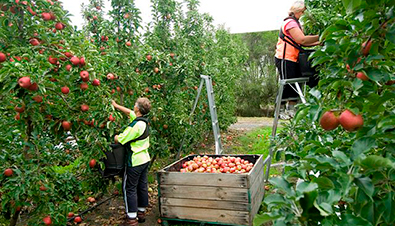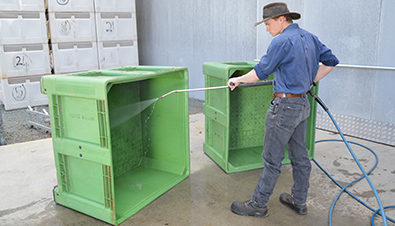Read the latest information on
Foot-and-mouth disease

Hygiene practices for product harvesting, sorting, packaging and storage activities, and disposal of waste materials minimise the risks associated with moving anything off your property. Image courtesy of APAL
Using good on farm hygiene reduces the risk of spreading pests and diseases and minimises the risks they pose to your business. This applies at all times of the year, but particularly so during harvest.
There are simple measures – like hygiene practices for product harvesting, sorting, packaging and storage activities, and disposal of waste materials – you can implement as part of your daily routine to minimise the risks associated with moving anything off your property.
Maintaining good on-farm hygiene when dealing with fruit and fruit by-products can minimise cross-contamination and breeding environments for pests and diseases.
To avoid cross contamination, wash away soil and plant residues in bulk bins before they are used for collecting this year’s crop.
Soil and plant material on harvested crops can also carry insect pests and disease organisms into the sorting and packing sheds. Check all the harvested crops over the sorting bench, removing any unwanted material. Ensure staff are made aware of what to look out for.
To minimise post-harvest contamination, only potable water should be used for washing fruit and vegetable produce as part of packaging operations.
Farm, orchard and plantation produce can be stored on-farm for a number of reasons. However, incorrect harvest, packing or storage of these products can provide an opportunity for pests and diseases to infest and ruin products. Storage structures can also provide an excellent breeding ground for pests and diseases, which can then spread and infect other parts of your property.
Poorly discarded plant waste can spread bacteria, viruses and pests, so ensure you have an adequate and secure waste disposal collection point away from your existing stock and water. Once all waste material is collected, remove it right away from your production and packing areas and dispose of appropriately by composting, burning, burying or disposal at a dedicated waste facility.
In the orchard at the end of harvest, you can mulch healthy leaf litter and plant waste back into the soil. This is good for recycling important nutrients, but at the same time it helps remove potential sites where pests and diseases can harbour between seasons.
If your plants are showing signs of disease, don’t spread it further by allowing it to leave your property.
It’s best to load fruit onto trucks on a concrete or bitumen pad outside the production areas.
Ensure that all transport providers abide by the cleaning and hygiene practices in place on your property. This includes ensuring trucks are clean if they need to enter production areas and before leaving.
You don’t want your plant stock, fruits and vegetables spoiled on-route to market, so make sure that your chosen transport providers take biosecurity and hygiene practices seriously.

Wash away soil and plant residues in bulk bins before they are used for collecting this year’s crop.
If you take your product to farmers markets, inspect and remove any produce that has signs of pest or disease damage. At the market, don’t share equipment and try to keep your stock separate from other producers’ stock.
As a general rule, try to not bring back unsold produce to your farm – you risk introducing new pests to your property. If you do, quarantine it and store it away from other stock to minimise the chance of transferring pests and diseases.
Wash and disinfect all equipment on arrival back at your property.
Pesticides and other chemical treatments must be applied with caution and in accordance with industry and government standards. Appropriate training and advice on the safe use of pesticides should be obtained before you use any chemicals to control pests. In most states and territories, anyone who applies pesticides and other chemicals must complete an accredited chemical training course such as ChemCert or SMARTtrain.
Chemical residues on plants and in animal products can result in rejection from export and domestic markets and can pose a risk to human health. Be sure to follow the instructions on the label and observe withholding periods. A ‘spray diary’ record should accompany each consignment of vegetables, fruits and nuts.
Be careful on how and where you use chemicals. The misuse of chemicals can also lead to the development of resistance by pests and diseases, potentially creating new biosecurity risks and challenges.
Responsibility for biosecurity doesn’t end when plant products or animals leave the farm gate. The measures in place on your property support biosecurity in your region. You have an important role to play in protecting your region and the entire industry from biosecurity threats.
Ultimately, your reputation and your business are at stake – every farm within a region may be affected in the event of a pest incursion or disease outbreak.
Watch the Farm Biosecurity video on outputs